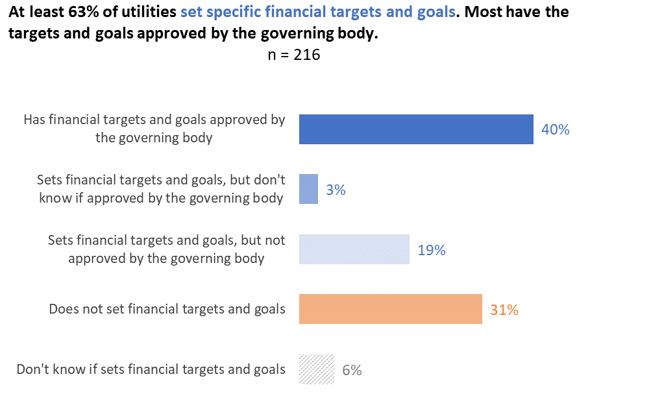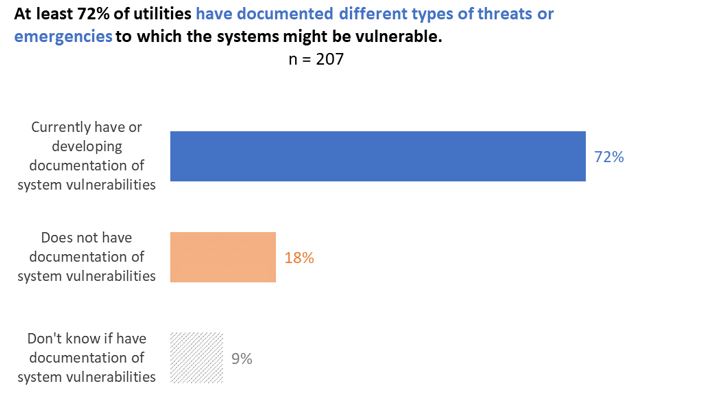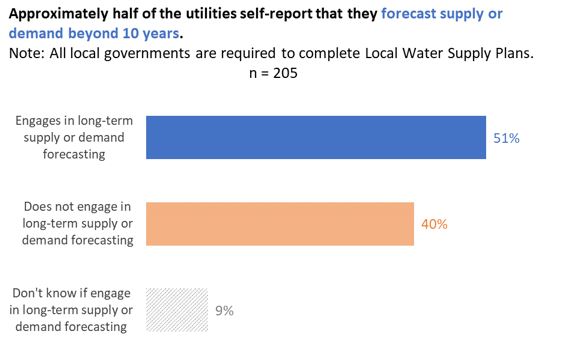|
|
Financial Resiliency and Future PlansBy CED Guest AuthorPublished February 26, 2019What could make the difference between a water or wastewater utility making it through an event like Hurricane Florence with relatively few impacts, and one that has major, lasting problems? Imagine two North Carolina utilities, just over the county line from one another, with the same assets that are exactly the same age, located at the same elevations. Will their ability to provide service after a storm be exactly the same? What type of things might they do before the storm hits to improve the outcome? Between November 2017 and March 2018, the North Carolina League of Municipalities (NCLM) and the Environmental Finance Center at the University of North Carolina at Chapel Hill (EFC) set out to answer these kind of questions through a statewide survey of utility management and long-term planning practices and policies. The notion was that utilities that undertake more planning for the future would show greater resiliency, as measured by financial stability and system performance (fewer regulatory violations). Using guidance from the American Water Works Association (AWWA) and other sources, five key types of long-term planning undertaken by water and wastewater utilities were identified: financial, asset management, capital improvement, disaster/emergency/resiliency, and long-range water resources planning. All North Carolina local government-owned utilities and many not-for-profit utilities were invited to participate in the survey. Of the 511 utilities invited to do so, 227, or 44 percent, participated in the survey. These utilities serve the vast majority of residents who are connected to public water and/or wastewater systems in North Carolina. For full details of the results, take a look at the summary report, or watch the summary webinar. Here are some of the highlights: Financial Planning
Asset Management Key assets include infrastructure and equipment such as pipes and pumps. Location of the asset is the most likely to be tracked, followed by age, operations and maintenance plan, and maintenance history. Capital Planning
Disaster/Emergency/Resiliency Planning System vulnerabilities utilities documented include natural disasters (62 percent), drought / water shortage (48 percent), and man-made disasters (29 percent). Long-term Water and Wastewater Resources Planning Putting it all Together Stay tuned for further analysis investigating the correlation, if any, between long-term planning and resiliency. In the meantime, are you interested in learning more about financial planning best practices and how they could benefit your community or utility? Watch this previous webinar on setting financial targets for water utilities. Financial targets include a minimum reserve balance for the enterprise fund, a certain number of days cash on hand, a specific debt service coverage ratio, or a maximum debt-per-customer level. In this webinar, EFC Senior Project Director Shadi Eskaf discussed financial targets and their benefits, and speakers from North Carolina utilities with outstanding financial performance (Stephen Winters from OWASA and Maria Hunnicutt from Broad River Water Authority) discussed their utilities’ targets, how they measure performance, and how they make decisions as a result of adopting this practice. A question and answer session at the end of the recording includes helpful insight from other North Carolina water professionals. Carol Rosenfeld is a senior project director at the Environmental Finance Center at the University of North Carolina at Chapel Hill. Her work focuses on financial models and mechanisms that governments, non-profits, universities, and other public organizations can implement to increase the deployment of energy efficiency and renewable energy. Carol holds a Master of Business Administration from the Yale School of Management and a degree in Civil and Environmental Engineering from Princeton University. |
Published February 26, 2019 By CED Guest Author
What could make the difference between a water or wastewater utility making it through an event like Hurricane Florence with relatively few impacts, and one that has major, lasting problems?
Imagine two North Carolina utilities, just over the county line from one another, with the same assets that are exactly the same age, located at the same elevations. Will their ability to provide service after a storm be exactly the same? What type of things might they do before the storm hits to improve the outcome?
Between November 2017 and March 2018, the North Carolina League of Municipalities (NCLM) and the Environmental Finance Center at the University of North Carolina at Chapel Hill (EFC) set out to answer these kind of questions through a statewide survey of utility management and long-term planning practices and policies. The notion was that utilities that undertake more planning for the future would show greater resiliency, as measured by financial stability and system performance (fewer regulatory violations).
Using guidance from the American Water Works Association (AWWA) and other sources, five key types of long-term planning undertaken by water and wastewater utilities were identified: financial, asset management, capital improvement, disaster/emergency/resiliency, and long-range water resources planning.
All North Carolina local government-owned utilities and many not-for-profit utilities were invited to participate in the survey. Of the 511 utilities invited to do so, 227, or 44 percent, participated in the survey. These utilities serve the vast majority of residents who are connected to public water and/or wastewater systems in North Carolina. For full details of the results, take a look at the summary report, or watch the summary webinar. Here are some of the highlights:
Financial Planning
Asset Management
Key assets include infrastructure and equipment such as pipes and pumps. Location of the asset is the most likely to be tracked, followed by age, operations and maintenance plan, and maintenance history.
Capital Planning
Disaster/Emergency/Resiliency Planning
System vulnerabilities utilities documented include natural disasters (62 percent), drought / water shortage (48 percent), and man-made disasters (29 percent).
Long-term Water and Wastewater Resources Planning
Putting it all Together
Stay tuned for further analysis investigating the correlation, if any, between long-term planning and resiliency.
In the meantime, are you interested in learning more about financial planning best practices and how they could benefit your community or utility? Watch this previous webinar on setting financial targets for water utilities. Financial targets include a minimum reserve balance for the enterprise fund, a certain number of days cash on hand, a specific debt service coverage ratio, or a maximum debt-per-customer level. In this webinar, EFC Senior Project Director Shadi Eskaf discussed financial targets and their benefits, and speakers from North Carolina utilities with outstanding financial performance (Stephen Winters from OWASA and Maria Hunnicutt from Broad River Water Authority) discussed their utilities’ targets, how they measure performance, and how they make decisions as a result of adopting this practice. A question and answer session at the end of the recording includes helpful insight from other North Carolina water professionals.
Carol Rosenfeld is a senior project director at the Environmental Finance Center at the University of North Carolina at Chapel Hill. Her work focuses on financial models and mechanisms that governments, non-profits, universities, and other public organizations can implement to increase the deployment of energy efficiency and renewable energy. Carol holds a Master of Business Administration from the Yale School of Management and a degree in Civil and Environmental Engineering from Princeton University.
Author(s)
Tagged Under
This blog post is published and posted online by the School of Government to address issues of interest to government officials. This blog post is for educational and informational Copyright ©️ 2009 to present School of Government at the University of North Carolina. All rights reserved. use and may be used for those purposes without permission by providing acknowledgment of its source. Use of this blog post for commercial purposes is prohibited. To browse a complete catalog of School of Government publications, please visit the School’s website at www.sog.unc.edu or contact the Bookstore, School of Government, CB# 3330 Knapp-Sanders Building, UNC Chapel Hill, Chapel Hill, NC 27599-3330; e-mail sales@sog.unc.edu; telephone 919.966.4119; or fax 919.962.2707.






